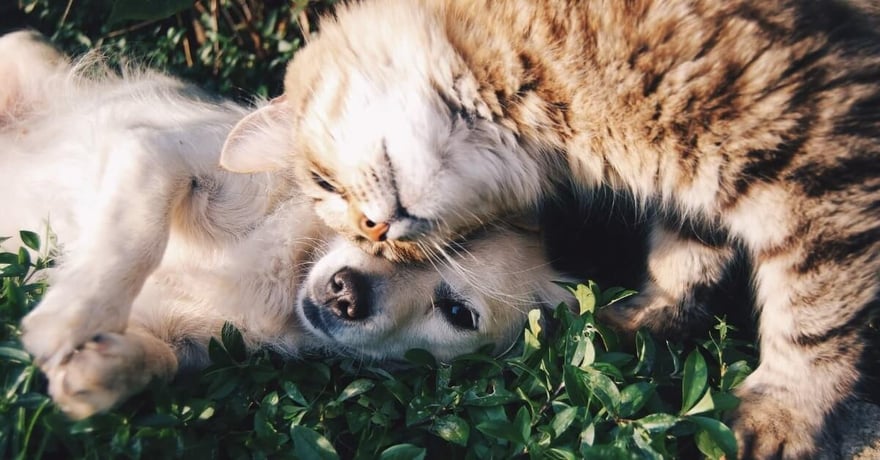How to Succeed When Introducing a Cat to a Dog

In the world of pet ownership, few scenarios are as heartwarming as the introduction of a new pet to your existing furry family. However, beneath the surface of this heartwarming moment lies the potential for tension, anxiety, and even hostility between your furry friends. The key to a harmonious coexistence? A well-planned and carefully executed introduction.
In this article, we'll guide you through the art of introducing a dog to a cat, step by step. Whether you're a seasoned pet owner looking to expand your furry family or a first-time pet parent embarking on this exciting journey, we'll help pave the way for a peaceful and loving relationship between your four-legged pals.
Understanding that dogs and cats have different communication styles, instincts, and temperaments is crucial. This article will delve into the psychology of both species, offering insights into their behaviors and reactions during the initial introduction phase.
Moreover, we'll provide you with practical strategies to ease the transition, including controlled meetings, scent swapping techniques, and the importance of creating safe spaces. By the end of this article, you'll have a comprehensive roadmap to help your dog and cat not only coexist but potentially form a bond that enriches your home and your heart.
Introducing Cats and Dogs
Step 1: Understand your Cat and Dog Personalities
Before you start the introduction process, it's crucial to comprehend the personalities and temperaments of your cat and dog. Cats can be territorial and may feel threatened by the presence of a new dog. On the other hand, dogs vary in their reactions to cats; some may be overly enthusiastic, while others may be more reserved.
For a successful introduction, consider factors like the cat's age, past experiences with dogs, and the dog's breed and age. A calm, well-trained dog with a low prey drive is typically a better candidate for cohabitation with a cat. Understanding these factors will help you tailor your introduction strategy to the specific needs of your pets.
Step 2: Create a Safe Haven for Your Cat
Your cat will need a safe space where it can retreat to if it feels overwhelmed during the introduction process. Set up a separate room for your cat with all its essentials – food, water, litter box, toys, and a comfortable hiding spot. Ensure this space is off-limits to the dog, allowing the cat to feel secure and in control of its environment.
Step 3: Gradual Scent Exchange
Before the physical introduction, allow your cat and dog to become familiar with each other's scents. Exchange bedding or toys between the two pets, giving them the opportunity to sniff and investigate each other's belongings. This helps them become accustomed to each other's presence in a non-threatening way.
Step 4: Controlled Visual Introduction
Once your pets are familiar with each other's scents, it's time for a controlled visual introduction. Use a baby gate or a pet gate to separate them while allowing them to see each other. This visual contact helps them get used to each other's presence without direct physical interaction. Observe their reactions closely during this phase.
Step 5: Leash and Crate Training
Leash and crate training can be essential for both your cat and dog during the introduction process. Keep your dog on a leash and your cat in a secure carrier or on a leash as well. Allow them to see each other from a distance while maintaining control over their movements. Reward calm and non-aggressive behavior with treats and praise.
Step 6: Gradual Physical Interaction
As your pets become more comfortable with each other's presence through visual contact, it's time to allow them to interact physically under close supervision. Keep your dog on a leash and let the cat approach at its own pace. Be patient and avoid forcing interaction; let them dictate the pace of their relationship.
Step 7: Positive Reinforcement
Throughout the introduction process, use positive reinforcement to reward good behavior from both your cat and dog. Treats, praise, affection, or even some new pet toys can help them associate each other's presence with positive experiences. Encourage calm and non-aggressive behavior, and avoid scolding or punishing either pet, as this can create anxiety and tension.
Step 8: Monitor Body Language
Understanding your pets' body language is crucial during the introduction phase. Look for signs of stress, fear, aggression, or curiosity. A relaxed tail, ears, and body posture indicate that your pets are comfortable, while raised hackles, hissing, growling, or barking can signify tension or aggression. If you notice any signs of aggression, separate them immediately and consult a professional trainer or behaviorist.
Step 9: Gradual Integration
As your cat and dog become more comfortable with each other, gradually increase their interaction time. Allow them to share common spaces under supervision, always prioritizing their safety and well-being. Continue to use positive reinforcement to reinforce positive behavior.
Step 10: Be Patient
The key to successfully introducing a cat to a dog is patience. The process may take weeks or even months, depending on your pets' personalities and how well they adapt to each other. Be prepared for setbacks and don't rush the process. Every pet is unique, and their relationship dynamics will develop at their own pace.
Final Thoughts
Introducing a cat to a dog requires careful planning, patience, and a deep understanding of your pets' personalities. By following the steps outlined in this comprehensive guide, you can increase the chances of a successful introduction and foster a harmonious coexistence between your furry companions. Remember that each cat and dog is unique, and the timeline for integration may vary. Always prioritize the safety and well-being of your pets, and don't hesitate to seek professional help if you encounter difficulties during the introduction process. With time, patience, and love, your cat and dog can become lifelong friends and bring joy to your household.
Now that you know how to introduce cats and dogs, you can feel comfortable getting that new kitten that you’ve been thinking about with more confidence and less apprehension. Remember that regardless of the dynamics you try to set up, pet insurance is always an important consideration for responsible pet owners.
Start your journey by getting a pet insurance quote from PHI Direct.
Posted on June 20, 2022 | Categories: Cats DOGS Kitten Puppy Training
Share


